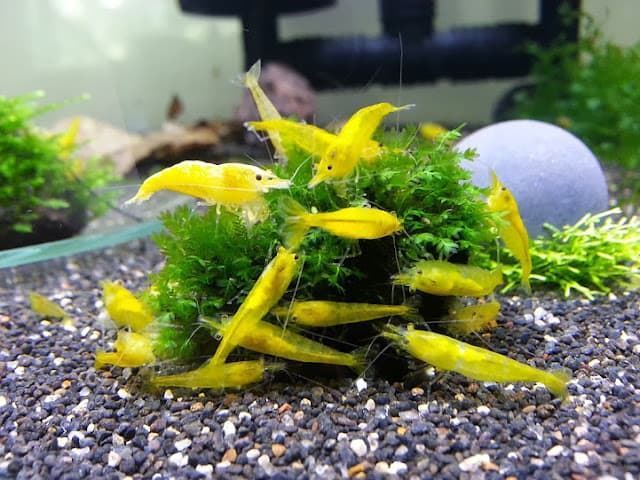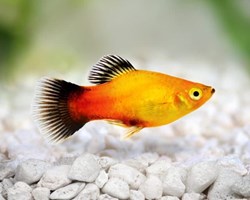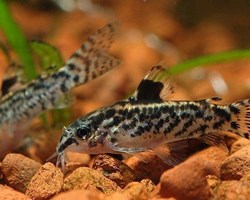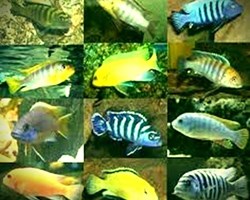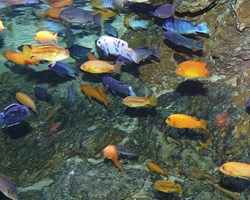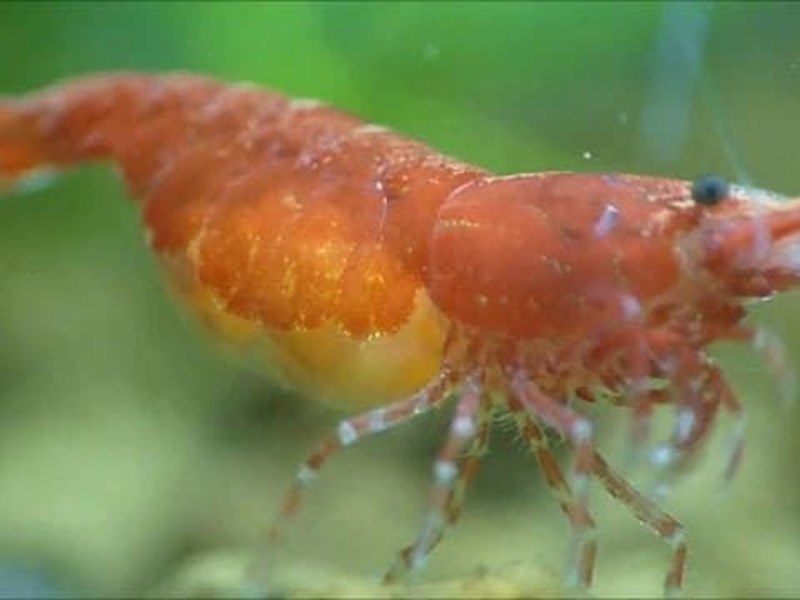
DESCRIPTION OF THE RED CHERRY SHRIMP:
SCIENTIFIC NAME: Neocaridina heteropoda.
ORDER: Decapoda.
FAMILY: Atyidae.
SUBFAMILY: Atyoidea.
The size is around 2.5 cm in length.
Its cephalothorax has 5 pairs of legs, including the pleopods, which are located at the base of the abdomen, which are used to move and stabilize the swim, as well as to keep the eggs oxygenated during their incubation.
They are usually found among the vegetation that is dragged by the current, also in clusters of leaves in backwaters of the rivers.
Neocaridina heteropoda "red" or "cherry shrimp", also known in English as "red cherry shrimp".
The Neocaridina heteropoda is native to Taiwan, it is a shrimp with variable coloration that combines gray, brown and dark tones, in different intensity, some are more transparent, others more colored.
The red variety of this shrimp was selected in Taiwan, it is the one that has become so popular, and we know it as “red cherry” shrimp or “cherry shrimp”.
Its red coloration, despite this, is variable, and depends on the genetic load, sex (females are more intensely colored than males), age (the color is accentuated) and mood (in the face of stress). pale).
The cherry red is a small shrimp, as an adult it does not usually exceed 2.5 cm, which makes it ideal for the aquarium, since it does not prey on smaller fish, unlike other shrimp such as the Macrobrachium.
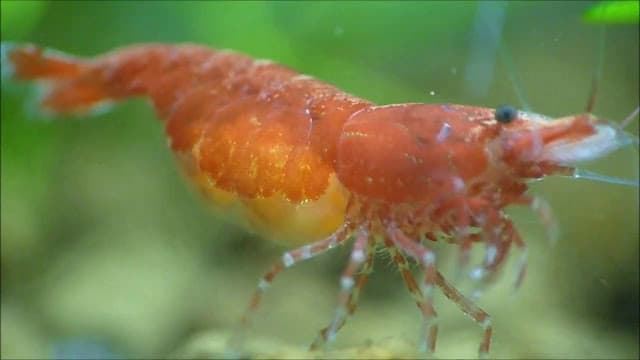
AQUARIUM CARE:
Red cherry can be kept in specific aquariums (prawns) or in community aquariums, together with other fish.
In large aquariums, densely planted and with not too large fish, adult cherry trees will have no problem breeding and large numbers of shrimp will manage to develop into adults.
Bottom fish, such as corydoras and loricariids, do not see shrimp as prey, although their comings and goings along the bottom may disturb them.
There are other invertebrates that are totally harmless to them, the snails. Even the largest ones, like the apple ones, are unable to catch even the newly hatched shrimp.
They can be kept in small aquariums, even 4l, planted and without filtration, with water changes and well planted, although the ideal would be a larger aquarium.
As it is a shrimp that breeds a lot, in a year we could have overpopulation, at Glu Glu Pet we recommend a shrimp tank of around 15-20l, if it is larger, even better.
As tankmates in the shrimp farm, at Glu Glu Pet we recommend some snails, they eat algae from the crystals and also share food with the shrimp.
If the aquarium is small, we can put Planorbis type snails, which do not exceed 2 cm.
They are one of the easiest hermaphrodite snails to control, since they do not grow as fast as others.
You can also put other types of snails such as Neritina, Vittina, and depending on the size of the aquarium, apple snails.
They are compatible: with other species of small shrimp, what happens is that if their population increases, they tend to inhibit the breeding of other species, less prolific.
They can be kept in an aquarium without a filter, but at least it should have water movement to prevent it from stagnating, change the water partially frequently and above all, a good amount of natural plants is essential.
But the ideal thing to avoid problems would be a filter, both indoor, waterfall and sponge, and that could not absorb the newly hatched cherry trees.
This is achieved with filters protecting the filter inlet with mesh or sponge.
Of course, this is to ensure the maximum number of offspring, but even without it we will still be able to breed them.
They are very prolific, and we will almost certainly discover a lot of small shrimp one day that have survived both the fish and the filter siphon.
Substrate: We can use both gravel and PAR sand or other substrates.
Plants: put a few natural plants.
For prawns they are very necessary, since they find their food source in them, especially when they are small.
The most recommended plant for shrimps: it is the Java moss.
Java moss provides excellent shelter for newly born cherry trees, and not only that, it also serves as food, both for the little ones, which peck at each other, and for the adults.
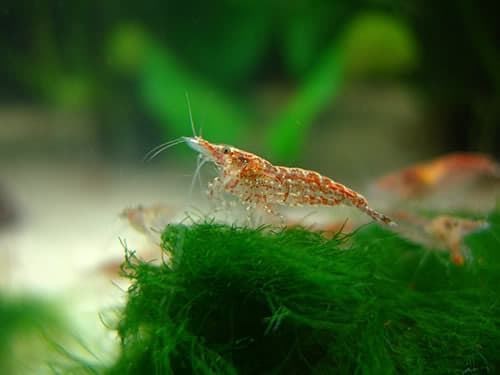

IDEAL WATER PARAMETERS:
Red cherry prawns are one of the most resistant and adaptable prawns in terms of water parameters, as well as temperature. Like other species, what harms them most are sudden changes.
They tolerate a pH between 6.5 and 7.5 and soft to semi-hard water, although the ideal would be a KH around 4º and a GH over 10º.
But they can be easily adapted to slightly harder water.
In terms of temperature, it is one of the prawns with the widest range of tolerance, although they prefer cooler temperatures than warm ones.
The ideal temperature for them is between 20 and 25ºC, they reproduce normally from 20ºC.
But shrimp, like all other invertebrates, are extremely sensitive to copper.
We must avoid the use of algaecides and fertilizers for plants with a high copper content, as well as medicines that are used to treat parasites, such as malachite green.
Thus, we must also avoid high levels of nitrates (ideally less than 20 mg/l), as well as ammonia and nitrites, which can be fatal.
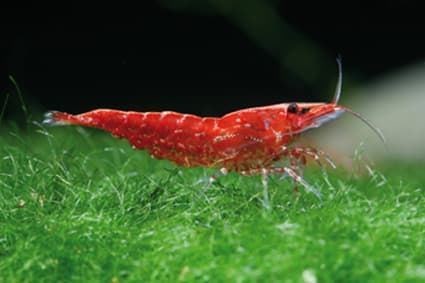
THE BEST NUTRITION FOR YOUR RED CHERRY SHRIMP:
The red cherry, like other species of shrimp, are totally omnivorous, so we will not have problems when it comes to feeding them.
Their diet will be based on green algae that they can find in the aquarium, and we will complement it by offering them food such as fish flakes, bottom pellets, freeze-dried dry food, seaweed, porridge, cooked vegetables (peas, spinach) and frozen food (larvae of mosquito, artemia, etc.).
There are foods that will enhance its red color, such as those rich in carotenoids and spirulina, although as we have said before, many things influence the color.
We must offer them the amount of food necessary to be completely consumed in a short time, if we have a lot of shrimp, we can repeat the dose several times a day, even after the lights go out.
Prawns also feed at night.
LIFE EXPECTANCY OF RED CHERRY SHRIMPS:
15 months.
Sexual Dimorphism: The females are larger than the males, having a more convex abdomen and more developed pleopods to transport the eggs.
Females tend to be more intensely colored than males.
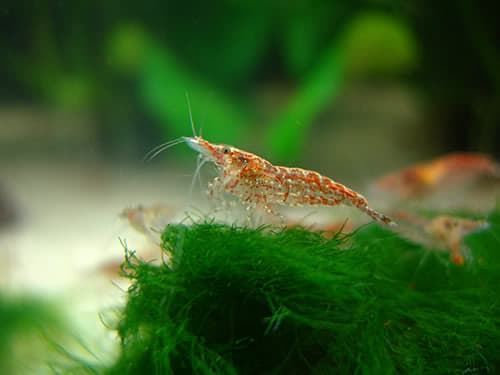
REPRODUCTION OF RED CHERRY SHRIMPS:
Contrary to some species of shrimp, such as the Caridina multidentata (formerly C. japonica) and the Macrobrachium (crystal shrimp), which require their larvae to pass through brackish water, the Neocaridina heteropoda is one of the species of shrimp that does everything their reproductive cycle in fresh water.
The larvae (actually zoeas) when they hatch from the egg are fully formed prawns and perfect miniature replicas of their parents, able to forage and manage on their own without any problem.
Its breeding is relatively easy in an aquarium, although obviously, we must have at least one male and one female to achieve reproduction.
Differentiating males from females is relatively easy in this species, but it is only reliable when the specimens are young or adults.
In the smallest specimens (1 cm or less) it is very difficult because both males and females have a similar appearance, we should not trust the coloration.
When they are small, there may be very pale females that will later become colored.
Females are generally more colorful than males, ranging in color from mottled red to solid, even deep cherry, to brownish red.
The females also have a broader abdomen and longer pleopods to be able to hold the eggs, and above all a characteristic feature: a yellow or greenish-yellow spot behind the head (cephalothorax).
This yellow spot represents unfertilized eggs, and is indicative of a mature female.
Mating takes place belly to belly, so the male, without letting go of her, tries to get under her or wrap his abdomen around her from the side.
If the female rejects him, she will make him fall with a strong shake of her body, although we will notice that the female is very weak, her exoskeleton has not yet hardened and her movements are very difficult.
When the male has managed to get into the correct position, he will pass on his spermatophores, which the female will store in that cavity.
The female will then use the deposited sperm to fertilize the eggs as she releases them from her body.
Each fertilized egg will be placed among its various rows of well-ordered pleopods; Depending on the size of the female, it can lay between 20 and 70 yellow eggs.
It will keep them attached thanks to a kind of “hair” that each of its pleopods have, which it will constantly move, day and night, to keep the eggs oxygenated.
The eggs will take between 3 and 4 weeks to hatch, depending on the temperature, the higher the temperature, the less time.
Eggless females become much more shy and cautious than eggless females or males. They will try to spend most of the day hidden, especially if there are fish in the tank, protecting their precious cargo.
From approximately the second week, the eggs change color as the larvae inside evolve.
They go from being yellow to greenish or yellow-greenish.
A few days before hatching, the eggs darken from green to dark gray or gray-green.
It is a sign that there is little left for hatching.
The female hides, and as the larvae hatch, she shakes her pleopods and releases them.
What is born are fully formed prawns and perfect miniature replicas of their parents.
When they are born, they measure less than 2 mm and are whitish.
They immediately begin to feed themselves on microalgae that they find in the crystals or on the plants.
Depending on the temperature, they develop more or less quickly.
At 24-25ºC growth is faster than at 20ºC.
Approximately one month later they can measure about 3 mm.
Some are already beginning to notice the color, as small red spots on their body.
Between two and three months later, even at this young age, we can see beautifully colored prawns like this one, possibly a female, but at this size you can't be sure.
There are females that are less colored than others when they are small and that later, once they are adults, they develop almost all their color.
Newly hatched red cherry trees do not need any special food or care, as long as they have enough algae and/or Java moss.
They will also eat small particles of food that we give to adults.
Curiously, the young are totally respected by the adults, who do not eat them, even the smallest ones.
In half a year we can have a beautiful aquarium full of prawns of all sizes, walking quietly and waiting every moment we feed them.
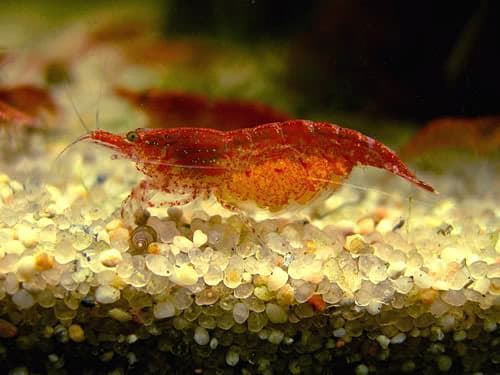
OTHER VARIETIES OF THE RED CHERRY SHRIMP:
NEOCARIDINA HETEROPODA RILI:
The Rili Shrimp came from Taiwanese breeders in 2010, and was highly sought after for its novel coloration, and combination of deep colors and light parts.
Rilis were first selectively bred from red neocaridines with white spots, bands, lines, and spots until the line was stabilized and made available to the public.
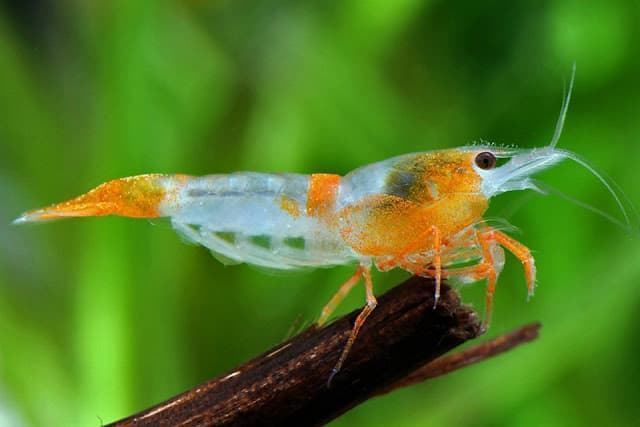
NEOCARIDINA HETEROPODA YELLOW:
The yellow or yellow prawn is one of the yellow prawns of the hobby, it is a selective breeding from the Red Cherry.
The origin of the yellow shrimp lies in Japan, its yellow color is a mutation of the Neocaridina Heteropoda, the date of its "creation" seems to be that it is around the year 2006, the name of the player or creator of this mutation is unknown so far.
The yellow shrimp is now spread all over the world, being either because of its bright, amazing color and being extremely prolific like the red cherry, and above all easy to care for.
